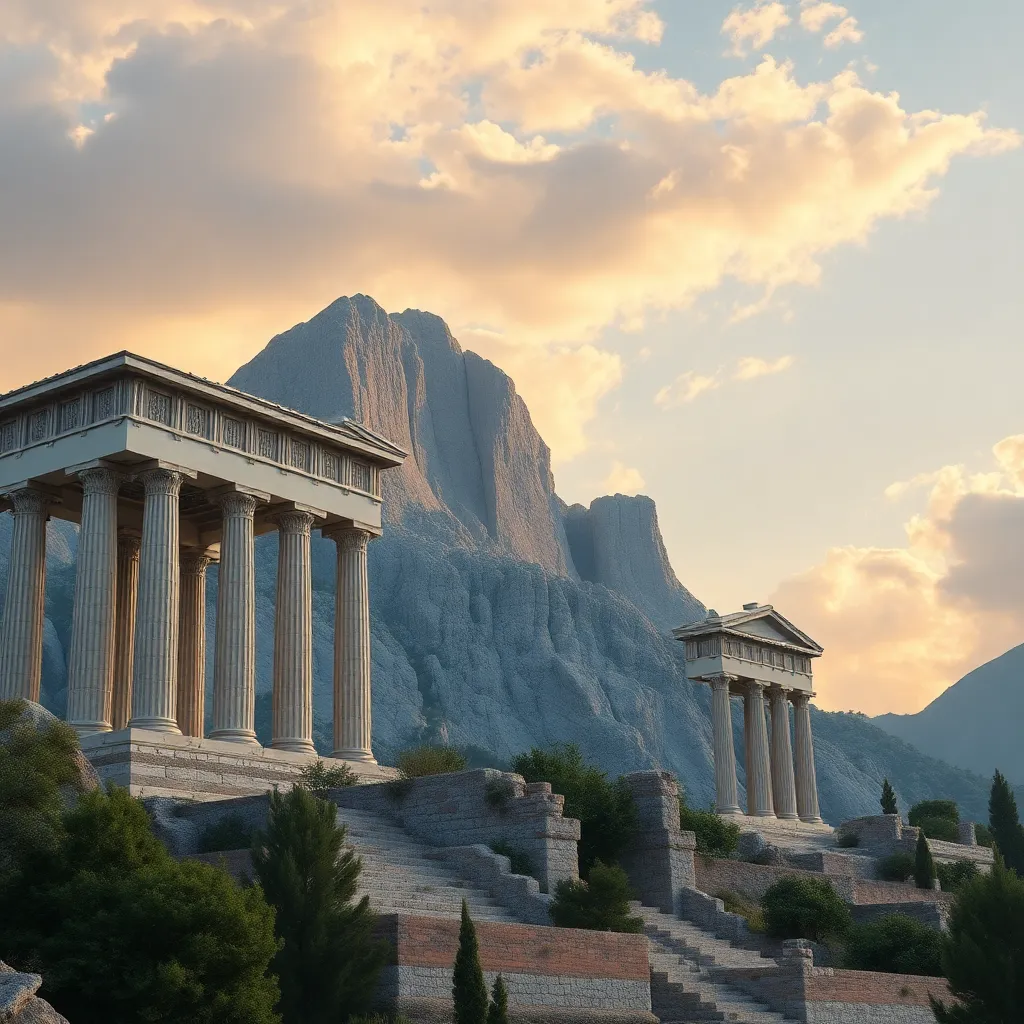The Influence of Mount Olympus on Ancient Greek Architecture
I. Introduction
Mount Olympus, the highest mountain in Greece, holds a significant place in Greek mythology as the home of the gods. With its majestic peaks and ethereal beauty, it has inspired countless tales and artistic expressions throughout history. The significance of Mount Olympus extends beyond mythology; it has profoundly influenced ancient Greek culture, particularly in architecture. This article explores how the divine and natural elements surrounding Mount Olympus shaped the architectural landscape of ancient Greece.
II. Mount Olympus: A Symbol of Divine Inspiration
In Greek mythology, Mount Olympus is not just a mountain but a divine realm where the gods reside, including Zeus, Hera, Poseidon, and Athena. This mythology created a profound connection between the landscape and the divine, inspiring architects and builders to create structures that reflected this celestial association. The gods were believed to favor certain locations, and this belief influenced where and how temples were constructed.
Architectural innovation in ancient Greece was often attributed to the inspiration drawn from the divine. For example, the grandeur and harmony of temple structures were thought to reflect the beauty and order of Mount Olympus itself. The following points summarize the connection between gods and architectural innovation:
- Temples were designed to honor the gods, often incorporating elements that symbolized their divine attributes.
- Architects sought to create spaces that evoked a sense of awe and reverence, mirroring the majesty of Olympus.
- Religious festivals and ceremonies often took place in these spaces, further intertwining architecture with divine worship.
III. Architectural Styles Inspired by Natural Landscapes
The natural forms and features of Mount Olympus had a profound influence on Greek architectural design. The mountain’s imposing presence and its surrounding landscape inspired architects to integrate these elements into their works. This connection between nature and architecture helped create a sense of harmony and balance within the built environment.
Key aspects of this influence include:
- The use of local materials that reflected the natural colors and textures of the landscape.
- Designing buildings that complemented the topography, often situated on elevated ground to align with the divine.
- Incorporating natural elements such as columns that mimicked the forms of trees or mountains.
Examples of buildings that reflect these natural elements include:
- The Parthenon, which embodies the harmony and proportions found in nature.
- The Temple of Zeus at Olympia, designed to reflect the grandeur of the surrounding landscape.
IV. Temples and Sacred Sites Dedicated to the Gods
Several prominent temples are located near Mount Olympus, each with unique architectural styles that reveal the cultural significance of the site. These sacred structures were often designed to inspire reverence and awe among worshippers, reflecting the divine connection to the mountain.
Notable temples include:
- The Temple of Zeus, known for its massive columns and intricate sculptures.
- The Sanctuary of Asklepios, which combined healing and worship, showcasing the intersection of architecture and spirituality.
The architectural styles of these sacred sites varied, with influences from Doric, Ionic, and Corinthian orders. The significance of location also played a crucial role in religious architecture, as temples were strategically built to align with celestial events or natural features, enhancing their spiritual significance.
V. The Role of Myths in Architectural Design
Myths were not only influential in the choice of architectural elements but also served as a source of symbolism embedded within structures. The stories of the gods and their interactions with mortals informed the design and decoration of temples and public buildings.
Examples of how myths influenced architectural design include:
- The use of specific motifs, such as the laurel wreath associated with Apollo, in decorative elements.
- Incorporating narrative reliefs that depict mythological events, enhancing the storytelling aspect of architecture.
Case studies of specific temples, such as the Temple of Athena Nike, illustrate these connections. The temple’s friezes depict scenes of gods and heroes, linking the physical structure to the mythology of Mount Olympus and enhancing its sacred nature.
VI. Urban Planning and Mount Olympus
Mount Olympus also influenced urban planning and the layout of cities. The presence of the mountain often dictated the orientation of civic spaces, public buildings, and temples. The integration of natural landscapes into urban design was a hallmark of ancient Greek civilization.
Key points regarding urban planning include:
- The arrangement of streets and public spaces often aimed to provide views of Mount Olympus, reinforcing its significance.
- Public buildings were strategically placed to create a sense of harmony with the environment.
- Religious beliefs shaped the design of cities, with sacred spaces integrated into the civic layout.
VII. Lasting Impact on Later Architectural Movements
The legacy of ancient Greek architecture, rooted in the influence of Mount Olympus, has persisted through subsequent periods. Roman and Byzantine architecture adopted many elements from Greek designs, adapting them to their contexts while retaining their reverence for the divine.
Contemporary interpretations of Greek architecture often reference Mount Olympus, as modern architects draw inspiration from its beauty and symbolism. Characteristics that have endured include:
- The use of columns and porticos in neoclassical architecture.
- Emphasis on symmetry, proportion, and harmony in design.
- Integration of natural landscapes into architectural compositions.
VIII. Conclusion
In summary, Mount Olympus has profoundly influenced ancient Greek architecture through its divine symbolism, natural beauty, and cultural significance. The interplay between mythology, nature, and architectural design created a rich tapestry of sacred spaces that served both religious and civic purposes. The echoes of Mount Olympus continue to resonate in modern architecture, reminding us of the enduring legacy of ancient Greece.
As we reflect on the influence of Mount Olympus, we recognize its vital role in shaping not only the architectural landscape of ancient Greece but also the collective imagination of cultures that followed, highlighting the timeless connection between nature, mythology, and human creativity.




